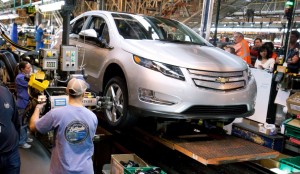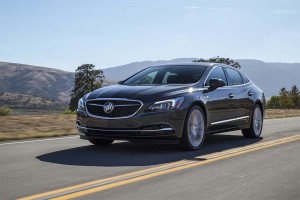
GM is idling its Detroit-Hamtramck facility where it builds the Chevy Volt and three other vehicles.
General Motors plans to temporarily shut down its Detroit-Hamtramck Assembly plant due to falling demand for the four vehicles built at the plant. The move idles more than 1,800 hourly and salaried employees.
Detroit-Hamtramck Assembly, also known as the Poletown plant, builds the Chevy Impala, Chevy Volt, Cadillac CT6 and Buick LaCrosse.
The plant will begin reducing production levels Oct. 20, culminating in the shutdown on Nov. 13, which will last through the end of 2017. It’s the second time this year GM’s been forced to cut personnel from the plant, letting more than 600 temporary employees go in late spring.
The company’s been quick to adjust its production rates and personnel levels to demand for products. It cut the third shift at its Spring Hill, Tennessee, plant earlier this year and another 1,000 temporary workers were furloughed last month as sales of the Cadillac XT5 and GMC Acadia have slumped.
(Six GM models may join growing line-up of cars going to graveyard in 2018. To see more, Click Here.)
The latest move is being made for the same reason. While the Impala is selling fine, the CT6 inventory is backing up. Currently, its at 115-days supply, according to Autodata, which is well above the industry standard of 60 days.

The Buick LaCrosse is one of six cars rumored to be getting the ax as GM focuses on producing more SUVs and crossovers.
The Chevy Volt was at 102 days at the end of September, and the LaCrosse is good for 10 months if the company doesn’t build another. Overall, GM had 76-days supply for its entire car segment, according to Autodata Corp.
GM is in the midst of a hard look at its product line-up. In today’s market, where pickups, SUVs, CUVs and other light trucks account for almost two-thirds of new vehicle sales, it should be no surprise, then, that GM is seriously considering killing off six more passenger cars.
(Click Here to see details about GM’s layoffs at the Spring Hill plant.)
The complete list, according to Reuters:
- The Buick LaCrosse; a solid sedan but lost among the SUV models that have helped revive the long-struggling brand;
- The Cadillac CT6; introduced little more than a year ago as the brand’s new flagship;
- The Cadillac XTS, a front-drive model that never really fit and was widely expected to be killed off within a few more years;
- The Chevrolet Volt, a well-reviewed plug-in hybrid that hasn’t charged up the market;
- The Chevrolet Sonic, a small car that has largely vanished in today’s truck-centric market; and
- The Chevrolet Impala, also well-reviewed, but a victim of the shift from sedans to SUVs.
GM officials declined to discuss the Reuters report but other sources confirmed the six models are on the list. The company has laid off more than 4,000 U.S. workers since January with another 1,050 in September.
The company isn’t alone in the push to review and revise its product portfolios away from cars to trucks and utility vehicles. By next year, both the Dodge Dart and Chrysler 200 factories will be rolling out new light truck models for FCA.
Ford, meanwhile, is shifting its Focus sedan to a Chinese plant and converting its Michigan Assembly Plant, a half-hour west of Detroit, to produce two revived truck nameplates: the Bronco SUV and the Ranger midsize pickup.
(UAW eyeing production levels at GM’s U.S. plants. Click Here for the story.)
GM also is working up an assortment of new light trucks. Cadillac, which could be hard hit by the current product review, is developing as many as three different new utility vehicles, brand boss Johan de Nysschen has told TheDetroitBureau.com.

As soon as they stop building cars, people will get sick of SUV’s and move back to cars. I own both, and appreciate both.
I remember just last year when Cadillac said it was going to try and fill every niche, like BMW. How times change, and how short sighted. Gas prices will go up again, and then people will want cars. Japan and Germany will offer them, but the US won’t, and then we will be faced with US automakers being caught with their pants down, again.
This, of course, begs the question, if you can only afford gas for your SUV if gas prices are low, should you be buying one in the first place? We have owned large pickups for the last 20 years. While it certainly wasn’t pleasant to fill it up when gas was over $4 a gallon, we are pretty price insensitive. I don’t think most people are like that.
One thing to remember, Paul, is that the mileage gap between an SUV and a comparably sized sedan is down to a couple mpg today. And folks often drop down a size when opting for a ute: say from midsize to compact, so they may not see a penalty at all.
Paul E,
That is an interesting thought, and also rarely reported (not a criticism of you, just an general observation). Mostly the way it is reported seems to be, “gas is cheap, so people are buying big SUVs.”
The larger point, though, is that a few years ago, people were dumping their SUVs in favor of cars because of gas mileage. You will recall this brought the Detroit 3 to their knees, and nearly drove 2 of them out of business. They then scrambled to develop cars which got higher mileage, which they are now discontinuing in favor of SUVs. I see a pattern here.
There are reasons to connect the dots, Paul, but there are also some factors to consider:
-The arrival of new car-based CUVs that are lighter, more aero and generally more efficient. The mileage gap between comparably sized — ie midsize sedan v midsize ute — is often just a couple mpg now, which is marginal when you’re looking at combined numbers in the high 20s and even 30s for today’s utes;
-People often step down a size class when opting for utes: a midsize sedan owner switching to a compact crossover;
-new engine tech, espec hybrid and plug-in, is becoming more commonplace. All Volvos are migrating to some electrified driveline, for example. So the mileage issue will become even less relevant.
Could fashions shift? Absolutely, but “crossover” is such an amorphous term that we see lots of interesting experiments that could mitigate a rush back to sedans and coupes.
Paul E.
All good points, especially regarding the amorphous term “crossover.”